Volume 2 | Number 2 | November 2010
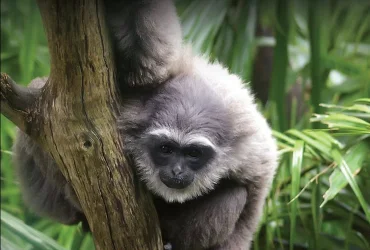 v2i2.35
v2i2.35ISSN: 1800-427X (print)
eISSN: 1800-427X (online)
DOI:10.47605/tapro.v2i2.35
Submitted date: 06 March 2011
Accepted date: 22 April 2011
Published date: 30 April 2011
Pp. 105-108.
Utilization of food plant species and abundance of hanuman langurs (Semnopithecus entellus) in Pench Tiger Reserve, Madhya Pradesh, India
Aniruddha Majumder*, Abinash Parida, K. Sankar & Qamar Qureshi
*Corresponding author. E-mail: aniruddha@wii.gov.in
Utilization of food plant species and abundance of hanuman langurs (Semnopithecus entellus) were studied between January 2009 and August 2010 in Pench Tiger Reserve, Madhya Pradesh (78° 55’ to 79° 35' E and 21° 8' to 22° N), India.
Section Editor: Lee Harding
eISSN: 1800-427X (online)
DOI:10.47605/tapro.v2i2.35
Submitted date: 06 March 2011
Accepted date: 22 April 2011
Published date: 30 April 2011
Pp. 105-108.
Utilization of food plant species and abundance of hanuman langurs (Semnopithecus entellus) in Pench Tiger Reserve, Madhya Pradesh, India
Aniruddha Majumder*, Abinash Parida, K. Sankar & Qamar Qureshi
*Corresponding author. E-mail: aniruddha@wii.gov.in
Utilization of food plant species and abundance of hanuman langurs (Semnopithecus entellus) were studied between January 2009 and August 2010 in Pench Tiger Reserve, Madhya Pradesh (78° 55’ to 79° 35' E and 21° 8' to 22° N), India.
Section Editor: Lee Harding
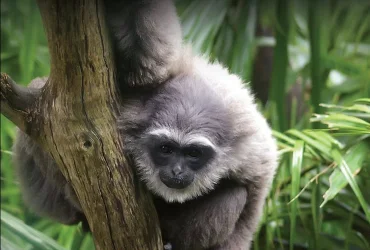 v2i2.34
v2i2.34ISSN: 1800-427X (print)
eISSN: 1800-427X (online)
DOI:10.47605/tapro.v2i2.34
Submitted date: 07 October 2010
Accepted date: 22 January 2010
Published date: 30 April 2011
Pp. 104.
Hemidactylus parvimaculatus Deraniyagala, 1953 (Reptilia : Gekkonidae) feeds on Ramanella variegata (Stoliczka, 1872) (Amphibia : Microhylidae) in Sri Lanka
D.M.S. Suranjan Karunarathna & A.A. Thasun Amarasinghe*
*Corresponding author. E-mail: thasun.taprobanica@gmail.com
The gecko genus Hemidactylus comprises seven species/sub-species in Sri Lanka and is thus the second largest gecko genus of the island. Here we record first observation of amphibian predation by H. parvimaculatus in an anthropogenic habitat in Sri Lanka.
Section Editor: Aaron Bauer
eISSN: 1800-427X (online)
DOI:10.47605/tapro.v2i2.34
Submitted date: 07 October 2010
Accepted date: 22 January 2010
Published date: 30 April 2011
Pp. 104.
Hemidactylus parvimaculatus Deraniyagala, 1953 (Reptilia : Gekkonidae) feeds on Ramanella variegata (Stoliczka, 1872) (Amphibia : Microhylidae) in Sri Lanka
D.M.S. Suranjan Karunarathna & A.A. Thasun Amarasinghe*
*Corresponding author. E-mail: thasun.taprobanica@gmail.com
The gecko genus Hemidactylus comprises seven species/sub-species in Sri Lanka and is thus the second largest gecko genus of the island. Here we record first observation of amphibian predation by H. parvimaculatus in an anthropogenic habitat in Sri Lanka.
Section Editor: Aaron Bauer
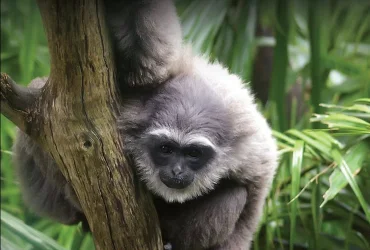 v2i2.33
v2i2.33ISSN: 1800-427X (print)
eISSN: 1800-427X (online)
DOI:10.47605/tapro.v2i2.33
Submitted date: 14 February 2011
Accepted date: 08 March 2011
Published date: 30 April 2011
Pp. 97–103.
SOCIAL BEHAVIOURS OF CAPTIVE Hylobates moloch (PRIMATES : HYLOBATIDAE) IN THE JAVAN GIBBON RESCUE AND REHABILITATION CENTER, GEDE-PANGRANGO NATIONAL PARK, INDONESIA
Niki K. Amarasinghe & A.A. Thasun Amarasinghe*
*Corresponding author. E-mail: thasun.taprobanica@gmail.com
Abstract
Hylobates moloch, Silvery Gibbon occure on the Java island (in the western half of Java), Indonesia. This study presents preliminary data on social behaviours for Silvery Gibbon in captivity. All the individuals had an average active period from 6:30 hr to 16:00 hr (total 9.5 hours). Resting behaviour had the highest percentage (57.05% ± 0.45), followed by movement (21.99% ± 0.14), feeding ( 15.73% ± 0.34), courtship (5.16% ± 0.03), calling (2.35% ± 0.02), social behaviours (1.6% ± 0.09), agonistic behaviours (0.37 % ± 0.01), and copulation (0.05% ± 0.01). Gibbons showed two peaks of feeding, from 06:35 to 07:30 and from 14:35 to 15:30. Gibbons in the JGC made two types of calls: male solo and female solo calls. Males had a lower time budget for calling behaviour than females. All the gibbons showed four types of locomotor behaviours: brachiating, climbing, jumping (including ricocheting) and bipedal. The most frequent locomotor behaviour was brachiation type. All individuals in the study groups showed autogrooming. Courtship included approach, follow, and contact behavior. The copulation position was dorso-ventral. Stages of copulation consisted of intromission, pelvis thrusting, ejaculation, and dismounting except mounting.
Key words : affiliative, calling, feeding, locomotor, resting, silvery gibbon
Section Editor: Colin Groves
eISSN: 1800-427X (online)
DOI:10.47605/tapro.v2i2.33
Submitted date: 14 February 2011
Accepted date: 08 March 2011
Published date: 30 April 2011
Pp. 97–103.
SOCIAL BEHAVIOURS OF CAPTIVE Hylobates moloch (PRIMATES : HYLOBATIDAE) IN THE JAVAN GIBBON RESCUE AND REHABILITATION CENTER, GEDE-PANGRANGO NATIONAL PARK, INDONESIA
Niki K. Amarasinghe & A.A. Thasun Amarasinghe*
*Corresponding author. E-mail: thasun.taprobanica@gmail.com
Abstract
Hylobates moloch, Silvery Gibbon occure on the Java island (in the western half of Java), Indonesia. This study presents preliminary data on social behaviours for Silvery Gibbon in captivity. All the individuals had an average active period from 6:30 hr to 16:00 hr (total 9.5 hours). Resting behaviour had the highest percentage (57.05% ± 0.45), followed by movement (21.99% ± 0.14), feeding ( 15.73% ± 0.34), courtship (5.16% ± 0.03), calling (2.35% ± 0.02), social behaviours (1.6% ± 0.09), agonistic behaviours (0.37 % ± 0.01), and copulation (0.05% ± 0.01). Gibbons showed two peaks of feeding, from 06:35 to 07:30 and from 14:35 to 15:30. Gibbons in the JGC made two types of calls: male solo and female solo calls. Males had a lower time budget for calling behaviour than females. All the gibbons showed four types of locomotor behaviours: brachiating, climbing, jumping (including ricocheting) and bipedal. The most frequent locomotor behaviour was brachiation type. All individuals in the study groups showed autogrooming. Courtship included approach, follow, and contact behavior. The copulation position was dorso-ventral. Stages of copulation consisted of intromission, pelvis thrusting, ejaculation, and dismounting except mounting.
Key words : affiliative, calling, feeding, locomotor, resting, silvery gibbon
Section Editor: Colin Groves
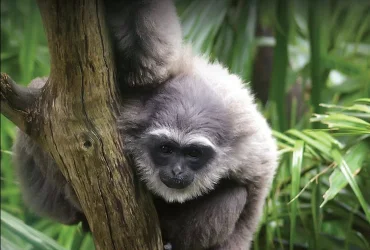 v2i2.32
v2i2.32ISSN: 1800-427X (print)
eISSN: 1800-427X (online)
DOI:10.47605/tapro.v2i2.32
Submitted date: 14 February 2011
Accepted date: 22 April 2011
Published date: 30 April 2011
Pp. 95–96, Pl. 6.
TWO NEW MELIOLACEAE MEMBERS FROM KERALA, INDIA
V.B. Hosagoudar* & A. Sabeena
*Corresponding author. E-mail: vbhosagoudar@rediffmail.com
Abstract
This paper gives an account of two new species, namely, Asteridiella sebastianiae and Meliola gluticola, infecting leaves of Sebastiania chamaelea and Gluta travancorica. Both these fungal species are new and are described, illustrated and compared with most similar taxa.
Key words : Asteridiella, fungi, Gluta travancorica, Meliola, new species, Sebastiania chamaelea
Section Editor: Kevin Hyde
eISSN: 1800-427X (online)
DOI:10.47605/tapro.v2i2.32
Submitted date: 14 February 2011
Accepted date: 22 April 2011
Published date: 30 April 2011
Pp. 95–96, Pl. 6.
TWO NEW MELIOLACEAE MEMBERS FROM KERALA, INDIA
V.B. Hosagoudar* & A. Sabeena
*Corresponding author. E-mail: vbhosagoudar@rediffmail.com
Abstract
This paper gives an account of two new species, namely, Asteridiella sebastianiae and Meliola gluticola, infecting leaves of Sebastiania chamaelea and Gluta travancorica. Both these fungal species are new and are described, illustrated and compared with most similar taxa.
Key words : Asteridiella, fungi, Gluta travancorica, Meliola, new species, Sebastiania chamaelea
Section Editor: Kevin Hyde
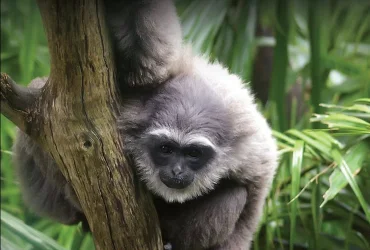 v2i2.31
v2i2.31ISSN: 1800-427X (print)
eISSN: 1800-427X (online)
DOI:10.47605/tapro.v2i2.31
Submitted date: 20 April 2010
Accepted date: 13 February 2011
Published date: 30 April 2011
Pp. 86–94, Pl. 5.
REPTILE DIVERSITY OF A FRAGMENTED LOWLAND RAIN FOREST PATCH IN KUKULUGALA, RATNAPURA DISTRICT, SRI LANKA
D.M.S. Suranjan Karunarathna & A.A. Thasun Amarasinghe*
*Corresponding author. E-mail: thasun.taprobanica@gmail.com
Abstract
A four month survey was undertaken to document the diversity and abundance of reptiles in the Kukulugala forest (KF) in the Ratnapura District, Sri Lanka. A total of 708 individuals belonging to 41 genera (~50%) and 13 families (~55%) were recorded. KF had high species diversity with 58 species, representing about ~28% of the total diversity of known reptiles of Sri Lanka. Of the recorded species, 11 (~19%) were threatened and 24 (~44%) are endemic to Sri Lanka. Endemic relict genera including Aspidura, Balanophis, Cercaspis, Lyriocephalus, Ceratophora, Lankascincus and Nessia were also recorded during the survey. Availability of varied microhabitats may be responsible for the observed high species diversity. Anthropogenic activities, particularly illegal logging and man-made forest fires, is threatening these habitats leading to reduction in reptile population and diversity.
Key words : Conservation, endemic, Ratnapura, reptiles, Sri Lanka, threatened, wet-zone
Section Editor: John Rudge
eISSN: 1800-427X (online)
DOI:10.47605/tapro.v2i2.31
Submitted date: 20 April 2010
Accepted date: 13 February 2011
Published date: 30 April 2011
Pp. 86–94, Pl. 5.
REPTILE DIVERSITY OF A FRAGMENTED LOWLAND RAIN FOREST PATCH IN KUKULUGALA, RATNAPURA DISTRICT, SRI LANKA
D.M.S. Suranjan Karunarathna & A.A. Thasun Amarasinghe*
*Corresponding author. E-mail: thasun.taprobanica@gmail.com
Abstract
A four month survey was undertaken to document the diversity and abundance of reptiles in the Kukulugala forest (KF) in the Ratnapura District, Sri Lanka. A total of 708 individuals belonging to 41 genera (~50%) and 13 families (~55%) were recorded. KF had high species diversity with 58 species, representing about ~28% of the total diversity of known reptiles of Sri Lanka. Of the recorded species, 11 (~19%) were threatened and 24 (~44%) are endemic to Sri Lanka. Endemic relict genera including Aspidura, Balanophis, Cercaspis, Lyriocephalus, Ceratophora, Lankascincus and Nessia were also recorded during the survey. Availability of varied microhabitats may be responsible for the observed high species diversity. Anthropogenic activities, particularly illegal logging and man-made forest fires, is threatening these habitats leading to reduction in reptile population and diversity.
Key words : Conservation, endemic, Ratnapura, reptiles, Sri Lanka, threatened, wet-zone
Section Editor: John Rudge
Hubungi Kami
The ultimate aim of the journal is to provide an effective medium for communication of the latest and best scientific information.
Copyright © 2020 Taprobanica. All Rights Reserved
Jasa Pembuatan Website by IKT




